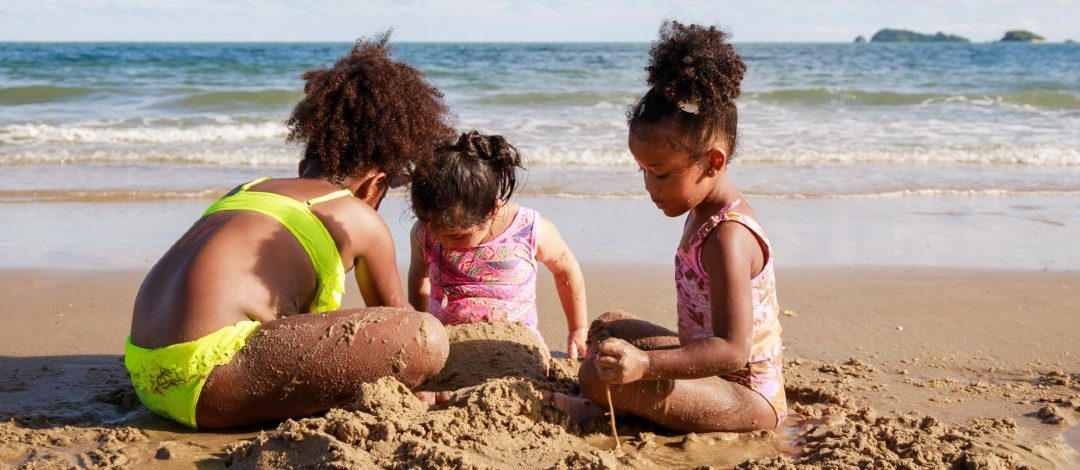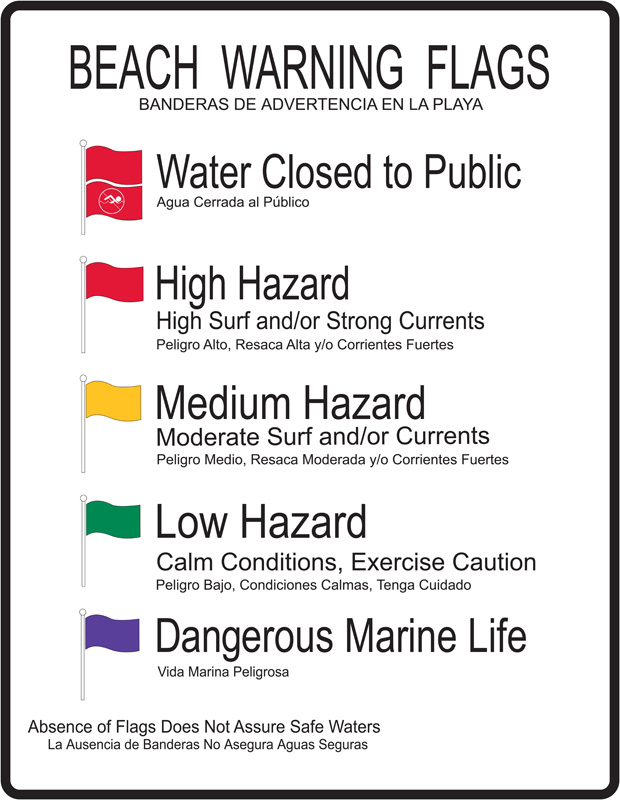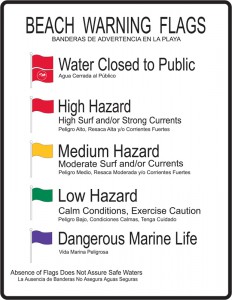
by Marie Arick | Jun 24, 2024

(Photo source: Marie Arick)
A great beach outing includes more than just grabbing the sunscreen and a towel on the way out the door. A bit of quick planning can really aid with a successful beach outing that doesn’t require too much effort.
Staying hydrated is important. Freezing bottles of water, sports drinks or fruit drink pouches is one trick to packing a smaller cooler or an insulated grocery bag. It is dual purpose. It can aid with keeping snacks (apple slices or watermelon in resealable bags) cool and when melted, a cool drink to enjoy.
Snacks are a also good idea. Fruit, animal crackers, or pretzels are easily packed and not too difficult to manage. Another tip is to bring a trash bag to keep the beaches clean and to limit your trips to the public waste receptacle.
Sunscreen is a necessity even on a cloudy day. A sun protection factor (SPF) of 15 or more by is recommended by the U.S. Food and Drug Administration (FDA). Applying sunscreen before leaving home allows time for adequate absorption into the skin. Remember to reapply at least every 2 hours. Using an umbrella or a tent is a great way to escape the sun’s direct rays. Wearing a hat or other protective clothing can help protect from those harmful UV rays.
Have kiddos? Bringing a few toys to aid with building sandcastles keeps the creative mind going. A few simple safety rules for playing in the sand are: do not bury one another in the sand, avoid throwing sand at anyone as it could harm one’s eyes, and avoid digging deep holes. Safety is paramount and an article published in the New England Journal of Medicine by a Harvard Medical School researcher noted burying a person in the sand is dangerous as the weight of the sand may lead to suffocation. As recently as February 2024, at Lauderdale by the Sea, two children were involved in a beach hole collapse, as reported in the Miami Herald. While digging in the sand is fun, be mindful and create structures that are safe for the kids.
Finally, know your beach flags and where to locate the current beach conditions. The National Weather Service as well as the MOTE Marine Laboratory are great sites providing beach conditions, including water current risk level, UV index, and thunderstorm potential. Local beaches often have social media pages that provide specific data for that area, including the current conditions and flags. Remember, not all beaches post flags and not all beaches have lifeguards on duty.
A day at the beach is an excellent opportunity for a fun-filled day. While this may not be an inclusive list, it does cover many of the basics of a good beach day. Spending a few minutes to determine the beach outlook, gathering the day’s supplies, and following some safety rules can greatly enhance your beach day.
An Equal Opportunity Institution.

by Ricki McWilliams | Jun 27, 2014
Have a Wonderful Summer in the Water
With the recent official start of Summer water related activities are in full swing. When you and your loved ones are around the water it is important to know the basic safety and survival skills.
Water-safety survival skills:
- floating or treading water for one minute without a flotation device
- stepping or jumping into water over your head and returning to the surface
- treading water or floating in a full circle and then finding a way out of the water
- exiting a pool without using a ladder
- swimming 25 yards (the length of a standard pool) without stopping
Only 56% of adults who say they can swim can perform the 5 critical water-safety skills that could save their lives. (American Red Cross)
It is important to know how to swim and make smart choices around the water:
- always swim in designated areas supervised by lifeguards
- always swim with a buddy
Our emerald waters and white sandy beaches make visiting the Gulf a fun, family weekend activity but it is important to look for the beach flag warning system and know what each flag means.
[important]
Flag Warning System:
- Double Red Flag: Water is closed to public (dangerous water conditions)
- Red Flag: High Hazard (high surf and/or strong currents)
- Yellow Flag: Medium Hazard (moderate surf and/or currents)
- Green Flag: Low Hazard (calm conditions, exercise caution)
- Purple Flag: Marine Pests Present (jellyfish, stingrays, dangerous fish)

[/important]
Thinking you can do more in the water than you are capable of can endanger you as well as others. A recent CDC report noted that about 21,000 children and young adults drowned from 1999 through 2010. For people aged 29 and younger, drowning is one of the top three causes of unintentional injury or death.
Contact your local UF/IFAS Extension agent, local community pool or the American Red Cross to find more information on swimming lessons, water-safety education programs, and training opportunities for lifeguards and water-safety instructors.
by Elizabeth | Jun 27, 2014
 Going to the beach or pool is a popular summer activity but did you know a child can drown in as little as one inch of water? Drowning is usually quick and silent. A child will lose consciousness two minutes after submersion, with irreversible brain damage occurring should the child survive. According to the Consumer Product Safety Commission, at least 350 children die each year from drowning, with most occurring in the summer months.
Going to the beach or pool is a popular summer activity but did you know a child can drown in as little as one inch of water? Drowning is usually quick and silent. A child will lose consciousness two minutes after submersion, with irreversible brain damage occurring should the child survive. According to the Consumer Product Safety Commission, at least 350 children die each year from drowning, with most occurring in the summer months.
Keep an eye on young children and prevent them from drowning. Here are a few points to consider when you are around water:
If you have a pool or spa, install a 4-foot fence around it. Besides lowering your insurance premiums, you will prevent direct access to the pool. Children are curious and move quickly; a “self-locking” latch on the gate provides the best obstacle for young children who might want to jump into the pool.
Install safety drain covers. These devices prevent a body part, hair, or clothing from being trapped by the drain cover. All public and private pools as well as spas are required to be fitted with a drain cover per the Virginia Graeme Baker Pool and Spa Safety Act of 2007. For specifications, visit www.poolsafely.gov.
Supervise your child. The most important preventive tactic is to supervise your child around water at all times. This means actively watching them, keeping them within arms’ reach, and not just glancing up every now and then. Don’t assume they will splash and yell for help if they get into trouble. Children can drown quietly in just a few minutes.
Learn to swim. Children can take formal swimming instruction from the age of four years. Water safety skills are included in the training. Swimming programs are available for younger children and babies, but the emphasis is on building confidence and encouraging the child to enjoy water, rather than teaching them to swim. However, children under age five may not be able to use these skills in an emergency so never rely on this to keep them safe.
Use flotation devices. If you buy personal flotation devices, like inflatable vests, make sure they conform to U.S standards – always check the label. You should think of these devices as something to help familiarize your child with water, not as a safety item. A flotation device is not a replacement for supervision. Always supervise your child, even when they are wearing their personal flotation device, in case they tumble upside-down or slip through the vest.
At the beach: Supervise your child at all times – don’t assume that a beach that was safe in the past is safe now, since the action of waves, weather, and wind can influence depth and currents. If the beach uses a color-coded flag warning system, check the flag color and heed the guidelines. Only take your child to beaches with lifeguard patrols. Make sure your child swims only in the protected area. Teach your child to float and raise an arm to signal for help from a lifeguard.
Going to the beach or pool is a lot of fun – keep it safe and always be alert around children. Have a great and safe summer!





